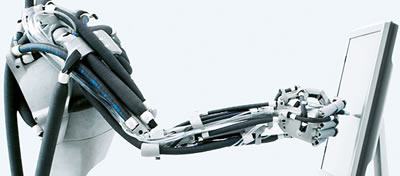Science Fiction
Dictionary
A B C D E F G H I J K L M N O P Q R S T U V W X Y Z
Robot Arm With Fluidic Muscles

Airic's_arm is a robotic arm inspired by your own arm. The company describes it as a "combination of mechatronics and the biological model of a human being."

(Festo Airic's arm - robotic biomimicry)
The mechanical foundation - the "skeleton" - of Festo's Airic's_arm is literally a metal version of the human skeletal structure. The radius and ulna (primary bones of the forearm), the metacarpals (hand and fingers) and the shoulder and shoulder blade are duplicated.
(Airic's_arm in action - video)
The musculature of the Festo Airic's_arm is comprised of Festo's "Fluidic Muscle," a pneumatic actuator of a type similar to those first demonstrated in the 1950's. Festo claims that their fluidic muscle design offers quicker repetition and high acceleration of mechanical parts, combined with a better power to weight ratio.
Festo's Airic's_arm is a pretty good fit for a specialized robotic arm from the 1958 Harry Harrison story Simulated Trainer:
He watched the panel slip back in the wall next to him and the hypo arm slide through, moving erratically like a snake as its metal fingers sought him out...
(Read more about Harry Harrison's hypo robotic arm)
Update 19-Oct-2011: Martin Caidin specifically uses this term in his 1972 novel Cyborg, which was the basis for the film Six Million Dollar Man; see the entry for artificial muscles. End update.
Try utilizing your own skeletal structure and "meat muscles:" click on one of these links to learn about other robotic arm research:
- Vanderbilt Robot Arm Has Steam-Powered Prothetics
- A radical hydrogen-peroxide-based power source gives this prosthetic limb its quickness and power.
- Arm-Wrestling Machine Rampage
- An arm-wrestling simulator machine popular in arcades has been pulled from service due to three separate reports of injuries to human players.
- Kuka Robot Bible Calligraphy
- The full Martin Luther bible copied out by a robotic (monk's!) hand.
Read more about the Festo Fluidic Muscle and Airic's_arm. I tried this Google search for Festo robotic arm videos; let me know if you find a better one.
Scroll down for more stories in the same category. (Story submitted 11/6/2007)
Follow this kind of news @Technovelgy.| Email | RSS | Blog It | Stumble | del.icio.us | Digg | Reddit |
Would
you like to contribute a story tip?
It's easy:
Get the URL of the story, and the related sf author, and add
it here.
Comment/Join discussion ( 2 )
Related News Stories - (" Robotics ")
Proof Of Robothood - Not A Person
'Who are you people? - Show 'em.' - James Cameron (1984).
Dancing Robots Taught Dance Moves
'A clockwork figure would be the thing for you...' Jerome K. Jerome, 1893.
Factory Humanoid Robots Built By Humanoid Robots
'...haven't you a section of the factory where only robot labor is employed?' - Isaac Asimov (1940).
Mornine Sales Robot
'Robot-salesmen were everywhere, gesturing...' - Philip K Dick, 1954.
Technovelgy (that's tech-novel-gee!) is devoted to the creative science inventions and ideas of sf authors. Look for the Invention Category that interests you, the Glossary, the Invention Timeline, or see what's New.
Science Fiction
Timeline
1600-1899
1900-1939
1940's 1950's
1960's 1970's
1980's 1990's
2000's 2010's
Current News
Natural Gait With Prosthetic Connected To Nervous System
'The leg was to function, in a way, as a servo-mechanism operated by Larry’s brain...'
Woman Marries Computer, Vonnegut's Dream Comes True
'Men are made of protoplasm... Lasts forever.'
Spidery 'Walk Me' Toyota Autonomous Wheel Chair Like Star Wars
Walk along with the emperor.
Dancing Robots Taught Dance Moves
'A clockwork figure would be the thing for you...'
Proof Of Robothood - Not A Person
'Who are you people? - Show 'em.'
Indonesian Clans Battle
'The observation vehicle was of that peculiar variety used in conveying a large number of people across rough terrain.'
The 'Last Mile' In China Crowded With Delivery Robots
Yes, it's a delivery robot. On wheels.
Tornyol Microdrone Kills Mosquitoes
'The real border was defended by... a swarm of quasi-independent aerostats.'
PLATO Spacecraft, Hunter Of Habitable Planets, Now Ready
'I ... set my automatic astronomical instruments to searching for a habitable planet.'
Factory Humanoid Robots Built By Humanoid Robots
'...haven't you a section of the factory where only robot labor is employed?'
iPhone Air Fulfils Jobs' Promise From 2007 - A Giant Screen!
'... oblongs were all over the floor and surfaces.'
ChatGPT Now Participates in Group Chats
'...the city was their laboratory in human psychology.'
iPhone Pocket All Sold Out!
'A long, strong, slender net...'
Did The Yautja Have These First?
What a marvel of ingenuity the little device was!
Jetson ONE Air Races Begin, Can Air Polo Be Far Behind?
'If you're one of those rarities who haven't attended a rocket-polo "carnage", let me tell you it's a colorful affair.'
Will Space Stations Have Large Interior Spaces Again?
'They filed clumsily into the battleroom, like children in a swimming pool for the first time, clinging to the handholds along the side.'
